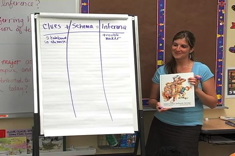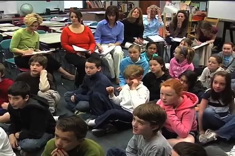PD2Go
Professional Development to Go
PD2Go is our master class in professional development for literacy leaders, bringing together our best videos for professional development with the tools to use them with colleagues. If you are delivering PD2Go remotely, check out our new guide with tips and templates.
Latest Videos
The Sponge Summary Lesson: Introduction
Heather Rader teaches a fourth-grade class, using the analogy of a sponge to explain how summaries work. In this video, the students review the four rules used for nonfiction summaries and corresponding kinesthetic movements and brainstorm a list of “what’s important to know about summaries.”
5th Grade Sentence Observation
Karen Terlecky leads students through a sentence study routine in her 5th grade classroom.
Listen In: Writing Reviews
In this video, Kincaid shares a complex system of recording beloved fantasy books and characters. Even though it wasn’t planned, Heather and Kincaid end up discussing reviews as a potential way to inform and explain the fantasy reading.
Using Comics in Literacy Workshops
Franki Sibberson works with her 3rd and 4th graders to use comics in the literacy workshop. Students study a variety of comics and list common attributes in small- and whole-group settings.
Picture Reading in First Grade
In this read-aloud lesson from Katie DiCesare's first-grade classroom, Katie demonstrates the importance of picture reading using the picture book The Zoo by Suzy Lee. Because the students need the pictures to help understand the characters, setting and events, they are able to see how pictures help us “think in the story” and “figure out the words.”
Staying Focused in Literacy Workshops
Clare Landrigan meets with a group of four 5th graders to talk about goal setting in reading workshop. Each student leaves with a specific goal for their reading.
Conferring in First Grade
This video from Katie DiCesare's first-grade classroom demonstrates a range of conferring in the midst of writing workshop -- from quick on the fly conferences, to small group brainstorming of ideas, to more sustained instruction of individual letter sounds and concepts.
Nonfiction Word Hunt
Word study and nonfiction reading are combined in Franki Sibberson's whole-group nonfiction word hunt activity. Each child shares which word he or she found, where it was found, and reflects on what the discoveries mean to the community of word learners.
Running and Reading Logs
Clare Landrigan and Tammy Mulligan have ideas to assess and refresh logs in the classroom. In this video excerpt, Clare uses the analogy of how runners use logs to chart progress and set goals and encourages the students to come up with a log that will help them as readers.
Expanding Definitions of “Just Right” Books
Tammy Mulligan works with two seven-year-olds to teach them strategies for building reading stamina. After discussing the “take a break” strategy, she introduces them to the “make a plan” strategy and has them practice.
Coaching in Kindergarten: Conferring
What's in a name? For kindergartner Maria, it's the start of learning how letters and sounds work. In this coaching session, Joan Moser of "The Sisters" helps Daniel understand how to use a child's name as a beginning point for teaching letters and sounds.
Listen In: About the Author
Heather Rader confers with second grader Myia over the “About the Author” piece she’s started on her own. Together they study mentor texts and generate attributes of good author biographies to lift the quality of Myia’s writing.
From Rages to Rags: Conferring with Conner
In this video, Sean Moore confers with Conner who is working on reading accurately. When he bumps into an unknown word, Sean reminds him of the kinesthetic motions for Does it look right? Does it sound right? Does it make sense?
Keeping the M
Preschool teacher Melissa Kolb works one-on-one with Daniela on the letters and sounds in her brother's name.
Inferring Read Aloud
In this whole-group minilesson, sixth-grade teacher Katie Doherty uses the book Wilfrid Gordon McDonald Partridge to have the students listen and chart their clues, schema and resulting inference.
Digging Deeper with Rereading
In this video from Katie DiCesare's first-grade classroom, Katie uses the strategy of rereading to help students look more closely at words - in this case, rhymes and word parts.
Science Workshop Whole Class Debrief
In this final video in a three-part series, Jennifer Morgan discusses what was learned during a science observation and writing activity in her grades 3 and 4 classroom. She charts and inquires while students share out what they learned.
“If You Like Matt Christopher” Student Book Share
In this video, two boys share other books beyond the writing of Matt Christopher that might interest their three classmates. The boys report on the books and describe components that are important to them.
Inferring and Word Learning in a Small Group
While demonstrating this lesson in front of teachers, Clare Landrigan uses the students’ previous work with inferring about author’s message to have them infer with unknown words they encounter in text.
Nonfiction Read Aloud (Part 1)
Sean Moore engages his second graders in a read aloud of the book Plants That Eat Animals. Sean varies the ways the students respond to the read aloud. He also chooses to read the text without showing any visual supports when he wants the students to create mental images, focus on vocabulary, or make connections between the text and their experiences.
Middle School Book Clubs: Response Options
Katie Doherty explains the options for response as students finish their books in book clubs. She meets with the readers of Sahara Special by Esme Raji Codell and discusses their plan for response.
Grade Level
Browse Videos By
Instructor
- Melissa Quimby
- Nawal Qarooni
- Gwen Blumberg
- Julie Cox
- The Lead Learners
- Hannah Tills
- Josie Stewart
- Ruth Metcalfe
- Mallory Messenger
- Becca Burk
- Jodie Bailey
- Vivian Chen
- Mary Brower
- Tiffany Abbott Fuller
- Stephanie Affinito
- Ruth Ayres
- Leigh Anne Eck
- Heather Fisher
- Shari Frost
- Julie Johnson
- Suzy Kaback
- Gigi McAllister
- Shirl McPhillips
- Melanie Meehan
- Cathy Mere
- Debbie Miller
- Tara Barnett and Kate Mills
- Tammy Mulligan
- Dana Murphy
- Bitsy Parks
- David Pittman
- Brenda Power
- Heather Rader
- Matt Renwick
- Mandy Robek
- Christy Rush-Levine
- Gretchen Schroeder
- Jen Schwanke
- Brian Sepe
- Katherine Sokolowski
- Stella Villalba
- Jennifer Vincent
Choice Literacy Membership
Articles
Get full access to all Choice Literacy article content
Videos
Get full access to all Choice Literacy video content
Courses
Access Choice Literacy course curriculum and training






















